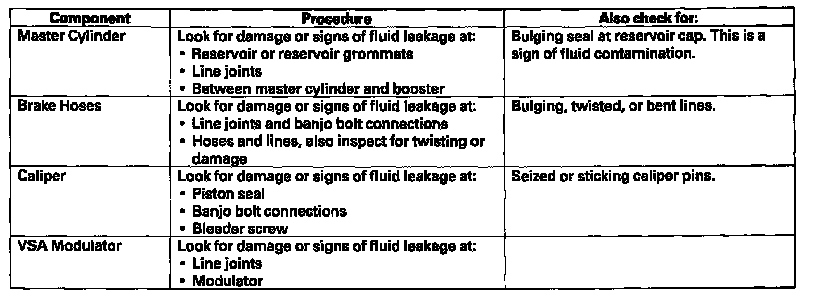Brakes and Traction Control: Testing and Inspection

Brake System Inspection and Tests
Brake System Test
Brake pedal sinks/fades when braking
1. Start the engine, and let it warm up to operating temperature.
2. Attach a 50 mm (2 inch) piece of masking tape along the bottom of the steering wheel, and draw a horizontal reference mark across it.
3. With the transmission in Neutral, press and hold the brake pedal lightly (about the same pressure needed to keep an A/T-equipped car from creeping), then release the parking brake.
4. While still holding the brake pedal, hook the end of the tape measure behind it. Then pull the tape up to the steering wheel, noting where the tape measure lines up with the reference mark you made on the masking tape.
5. Apply steady pressure to the brake pedal for 3 minutes.
6. Watch the tape measure.
^ if it moves less than 10 mm (0.4 inch), the master cylinder is OK.
^ if it moves more than 10 mm (0.4 inch) replace the master cylinder.
Rapid brake pad wear, vehicle vibration (after a long drive), or high, hard brake pedal
1. Drive the vehicle until the brakes drag or until the pedal is high and hard. This can take 20 or more brake pedal applications during an extended test drive.
2. With the engine running, raise the vehicle on a lift, and spin all four wheels by hand.
Is there brake drag at any of the wheels?
YES - Go to step 3.
NO - Look for other causes of the pact wear, high pedal, or vehicle vibration.
3. Turn the engine off, pump the brake pedal to deplete the vacuum in the brake booster, and then spin the wheels again to check for brake drag.
Is there brake drag at any of the wheels?
YES - Go to step 4.
NO - Replace the brake booster.
4. Without removing the brake lines, unbolt and separate the master cylinder from the booster, then spin the wheels to check for brake drag.
Is there brake drag at any of the wheels?
YES - Go to step 5.
NO - Check the brake pedal position switch adjustment and pedal free play.
5. Loosen the hydraulic lines at the master cylinder, then spin the wheels to check for brake drag.
Is there brake drag at any of the wheels?
YES - Go to step 6.
NO - Replace the master cylinder.
6. Loosen the bleeder screws at each caliper, then spin the wheels to check for brake drag.
Is there brake drag at any of the wheels?
YES - Disassemble and repair the caliper on the wheel(s) with brake drag.
NO - Look for a bulging master cylinder cap seal, discolored or contaminated brake fluid in the master cylinder, or damaged brake lines. If any of these items are damaged, replace them. If all of these items are OK, replace the VSA modulator.